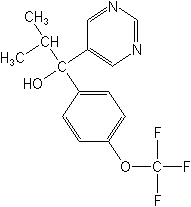-
Common NameFlurprimidol
-
中文通用名呋嘧醇
-
IUPAC(RS)-2-methyl-1-pyrimidin-5-yl-1-(4-trifluoromethoxyphenyl)propan-1-ol
-
CASα-(1-methylethyl)-α-[4-(trifluoromethoxy)phenyl]-5-pyrimidinemethanol
-
CAS No.56425-91-3
-
Molecular FormulaC15H15F3N2O2
-
Molecular Structure
-
Category
-
ActivityPlant Growth Regulator
Flurprimidol is active following foliar application and by injection or painting of the bark of deciduous trees. The product has systemic activity, being translocated in the xylem to the actively growing shoots and leaves. Flurprimidol acts by reducing internode and leaf elongation. It can suppress regrowth in ornamentals and turfgrass following trimming, although this can be unreliable in turfgrass under certain conditions. Its use in some flowering plants encourages darker green foliage and more inflorescences. Dow AgroSciences recommends a maximum of three applications of flurprimidol on ornamentals.
In field trials, flurprimidol has shown similar activity to paclobutrazol on turf. In common with most PGRs, it causes transient phytotoxicity on turfgrasses, particularly following multiple applications. It should not be applied to putting greens. Flurprimidol is unsuitable for use on unhealthy trees, trees producing sugar sap for consumption and for 12 months prior to harvesting in fruit and nut trees. -
CropUseCropUses:
fruit trees, ornamental trees, turf, ornamentals
Turf
184-275 g ai/ha
Flowers
0.0075 g ai/litre
-
Physical PropertiesMolecular weight:312.3; Physical form:Colourless crystals. Density:1.34 (24 °C); Melting point:93.5-97 °C; Vapour pressure:4.85 × 10-2 mPa (25 °C); Partition coefficient(n-octanol and water):logP = 3.34 ( pH 7, 20 °C); Solubility:In water 114 (distilled), 104 ( pH 5), 114 ( pH 7), 102 ( pH 9) (all in mg/l, 20 °C) ( OECD 105). In hexane 1.26, toluene 144, dichloromethane 1810, methanol 1990, acetone 15; Stability:After 5 d at pH 4, 7 and 9 (50 °C), <10% hydrolysis had occurred. Stable for at least 14 mo at room temperature. Photolytically decomposed in water, DT50 c. 3 h.
-
ToxicologyOral:Acute oral LD50 for male rats 914, female rats 709, male mice 602, female mice 702 mg/ kg. Percutaneous:Acute percutaneous LD50 for rabbits >5000 mg/kg. Slight to moderate irritant to skin and eyes (rabbits). Not a skin sensitiser (guinea pigs). Inhalation: LC50 (4 h) for rats >5 mg/l.
-
Environmental Profile
Ecotoxicology:
Algae: EC50 for Selenastrum capricornutum 0.84 mg/l.Bees: LD50 (contact, 48 h) >100 μg/bee.Birds:Acute oral LD50 for quail and mallard ducks >2000 mg/kg. Dietary LC50 (5 d) for quail 560, mallard ducks 1800 mg/ kg diet.Daphnia: LC50 (48 h) 11.8 ppm.Fish: LC50 (96 h) for bluegill sunfish 17.2, rainbow trout 18.3 ppm.
Environmental fate:
Animals:In mammals, the skin forms a significant barrier to absorption. Following oral administration, excretion follows in the urine and faeces within 48 hours, and more than 30 metabolites have been identified. No accumulation potential.
Fate in soil:
The half-life of flurprimidol ranges from 119 - 187 days depending on soil type. The product is strongly adsorbed to soil particles. It is degraded chemically. Under laboratory conditions, the leaching potential of the compound was determined as low.
Fate in aquatic systems:
Flurprimidol undergoes photolysis in water. The half-life ranges from 1.4 days in outdoor conditions to 29 days in glasshouses. -
Transport InformationSignal Word:CAUTION; Hazard Class:III(Slightly hazardous)
Porduct NewsMore
Orthosulfamuron boosts sugarcane production, study finds
Glyphosate price plummets 40% in one year in Argentina
Indian govt stops imports of herbicide Glufosinate priced below Rs 1,289 per kg
Carbendazim fungicide wins victory in Brazilian Parliament
Corteva presents new pre-emergent herbicide Linear for sugarcane in Brazil
Picloram Triclopyr Aminopyralid
Revolutionizing disease prevention: BASF launches new rice fungicide Cevya® in China
Thiamethoxam is allowed again in Brazil by a judicial decision
Bayer develops alternative to glyphosate herbicide

 0
0 Subscribe
Subscribe
